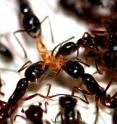Chemical warfare of stealthy silverfish
A co-evolutionary arms race exists between social insects and their parasites. Army ants (Leptogenys distinguenda) share their nests with several parasites such as beetles, snails and spiders. They also share their food with the kleptoparasitic silverfish (Malayatelura ponerophila). New research published in BioMed Central's open access journal BMC Ecology shows that the silverfish manage to hide amongst the ants by covering themselves in the ant's chemical scent. Myrmecophilous (ant-loving) silverfish live their lives in and amongst army ants. To avoid being killed or rejected from the nest the silverfish must be able to somehow persuade the ants to believe that they are not invaders. These ants have limited eyesight and live in a world of chemical cues, recognizing their colony members by scent. Christoph von Beeren and Volker Witte from the Ludwig Maximilian University, Munich, collected L. distinguenda ants and M. ponerophila silverfish from the tropical rainforests of Ulu Gombak, Malaysia and found that, while the ants had 70 distinct hydrocarbon compounds on their cuticles, silverfish had none that are distinct for them. Instead, they carried the host colony scent, a phenomenon known as chemical mimicry.
By tracking the transfer of tagged hydrocarbon from host ants to silverfish, it became apparent that the latter pilfered their host's scent, preferably by rubbing against defenseless 'callows' (immature ants). To avoid ant aggression silverfish must continually top-up this scent. Isolating silverfish from the colony resulted in them losing their protective scent and being targeted for chasing, seizing and biting by worker ants, sometimes resulting in their death.
Prof. Witte explained, "It seems that silverfish and ants are engaged in a co-evolutionary arms race. The ants have equipped themselves with a complicated scent recognition system to safeguard their nest from predators and parasites. While the ants were developing their nest protection strategy the silverfish evolved elaborate behavioral patterns, pilfering the hosts own recognition cues, to outwit the ant's chemical defenses. Consequently, the silverfish have access to food and shelter in the inner part of the ants nest without giving anything in return."
